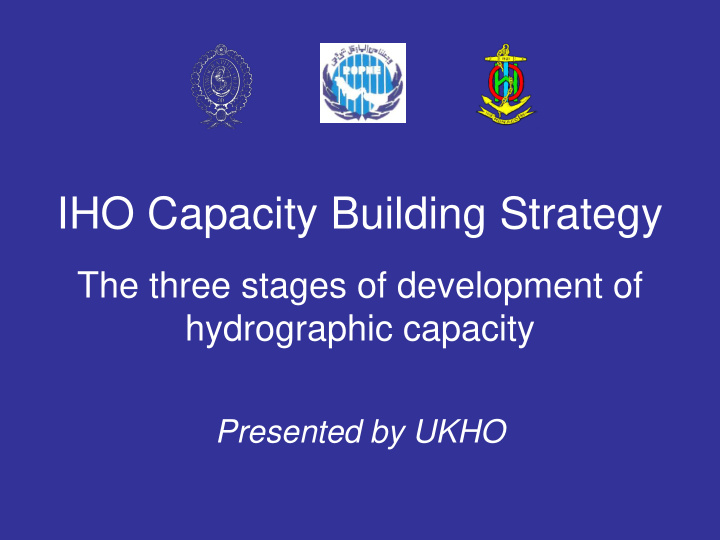



IHO Capacity Building Strategy The three stages of development of hydrographic capacity Presented by UKHO
Introduction ■ What is Capacity Building? ■ Background ■ IHO Capacity Building Strategy ■ The Three Phases of Capacity Building ■ The Process ■ More information? 5 th RSAHC MEETING, MARCH 2013 IHO Capacity Building Strategy
What is Capacity Building? The IHO defines Capacity Building as: “ the process by which the organization assesses the status of current arrangements and assists States to achieve sustainable development and improvement in their ability to meet hydrographic, cartographic and maritime safety obligations with particular reference to recommendations in UNCLOS, SOLAS, and other international instruments.” 5 th RSAHC MEETING, MARCH 2013 IHO Capacity Building Strategy
Capacity Building Background CB vital in efforts of intergovernmental technical organisations to support UN development goals IHO Capacity Building Sub Committee established in 2003 to co-ordinate effort. It has already: ■ Established IHO Capacity Building Strategy ■ Established approved Assessment Criteria for Development of Hydrographic Capability ■ Developed a Capacity Building Management Plan ■ Created Capacity Building Fund ■ Organized RHC Seminars and Technical Workshops ■ Provided support to students to attend Courses 5 th RSAHC MEETING, MARCH 2013 IHO Capacity Building Strategy
IHO Capacity Building Strategy To provide strategic guidance for IHO capacity building to ensure optimum contribution to safety of life at sea, to the protection of the environment, and to national economic development. Principles: ■ National needs and capacity for infrastructure development assessed against three phases of development ■ Skill / technology transfers provide appropriate, sustainable, solutions ■ Regional coordination/co-operation of CB projects ■ Capacity building to develop hydrographic services, supported by National Administration ■ Benefits from enduring output, not infrastructure 5 th RSAHC MEETING, MARCH 2013 IHO Capacity Building Strategy
IHO Capacity Building Strategy – Procedures Aim: To enable RHCs and CBSC to optimize funding RHCs submit inputs to CBSC by 1 April each year All RHCs to include C-55 and input to CBSC on their agendas Thorough assessment of submissions by RHC Chairs 5 th RSAHC MEETING, MARCH 2013 IHO Capacity Building Strategy
Three Phases of Capacity Building Three phases defined in IHO Publication M-2: Downloadable for free from www.iho.int 5 th RSAHC MEETING, MARCH 2013 IHO Capacity Building Strategy
Three phases of CB development – Phase 1 Collection and circulation of nautical information, necessary to maintain existing charts and publications up to date ■ Form National Maritime Safety Committee or National Hydrographic Committee ■ Create/improve current infrastructure to collect and circulate information ■ Strengthen links with charting authority to enable updating of charts and publications ■ Minimal training needed 5 th RSAHC MEETING, MARCH 2013 IHO Capacity Building Strategy
Three phases of CB development – Phase 2 Creation of a surveying capability to conduct: Coastal projects; Offshore projects ■ Establish capacity to enable surveys of ports and their approaches ■ Maintain adequate aids to navigation ■ Build capacity to enable surveys in support of coastal and offshore areas ■ Build capacity to set up hydrographic databases to support the work of the NMSC/NHC ■ Requires funding for training and equipment or contract survey 5 th RSAHC MEETING, MARCH 2013 IHO Capacity Building Strategy
Three phases of CB development – Phase 3 Produce paper charts, ENC and publications independently ■ Is Phase 3 needed? (requires high investment for production, distribution and updating) ■ Alternatively, bi-lateral agreements for charting can provide easier solutions in production and distribution (of ENC through RENCs) and rewards. 5 th RSAHC MEETING, MARCH 2013 IHO Capacity Building Strategy
The Process – Four Steps ■ Awareness : IHB to campaign for establishment of the hydrographic services: to meet obligations under UNCLOS and SOLAS; to explore best means of raising awareness of the importance of hydrography in the funding agencies ■ Assessment : C-55, Technical Visits ■ Analysis : C-55, Technical Visits ■ Action : Contact with decision-makers; advice to national experts; IHO and RHC assistance in co-ordination of regional survey, charting and MSI projects, includes advice on liaison with funding agencies and with industry Bilateral assistance by other IHO Member States, by MOU, or on contract or aid-funded basis 5 th RSAHC MEETING, MARCH 2013 IHO Capacity Building Strategy
More Information? Contacts IHO Technical Visits IHO Technical Workshops RSAHC Chair (or RSAHC CB Coordinator) IHB Bilateral partners Source material IHO website – www.iho.int Capacity Building Sub Committee IHO publication M-2 5 th RSAHC MEETING, MARCH 2013 IHO Capacity Building Strategy
Questions Any Questions? 5 th RSAHC MEETING, MARCH 2013 IHO Capacity Building Strategy
Recommend
More recommend